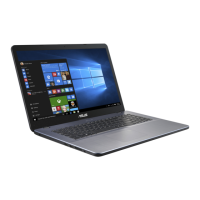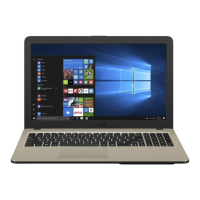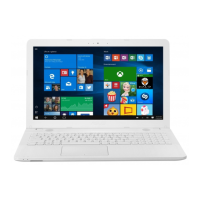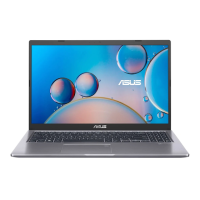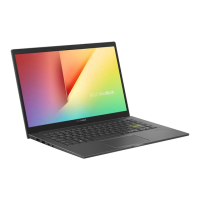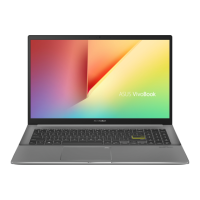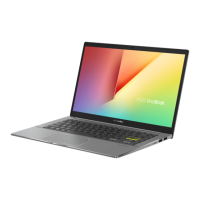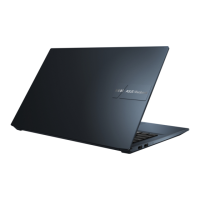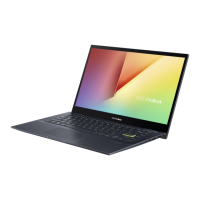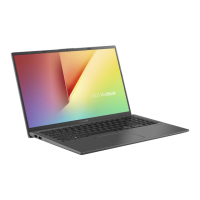Do you have a question about the Asus VivoBook X712F and is the answer not in the manual?
Details the hardware components of your Notebook PC.
Illustrates the top view of the Notebook PC with numbered components.
Details components located on the bottom side of the Notebook PC.
Identifies ports and components on the right side of the Notebook PC.
Identifies ports and indicators on the left side of the Notebook PC.
Provides initial steps to start using the Notebook PC.
Instructions on how to connect the power adapter and charge the battery.
Guidance on how to open the laptop screen.
Instructions on how to turn on the Notebook PC.
Explains how to use the touchpad for navigation.
Details keyboard functions, including HotKeys and special keys.
Lists the functions of special keyboard hotkeys.
Explains the usage of the function keys.
Describes the special Windows keys on the keyboard.
Instructions on how to use the numeric keypad.
Guide to initial Windows 10 setup and configuration.
Explains the functionality and usage of the Windows Start menu.
Details the tiled apps available in the Windows Start menu.
Instructions on launching, customizing, and closing Windows apps.
Steps to move, resize, pin, or unpin apps.
How to switch between apps and desktops using Task View.
Explains how to display apps side-by-side for multitasking.
Describes using hotspots to snap applications into place.
Consolidates notifications and quick actions in Windows.
Lists useful keyboard shortcuts for navigation and launching apps.
Steps to connect to wireless networks.
Steps to connect the Notebook PC to a Wi-Fi network.
Guide to pairing and using Bluetooth-enabled devices.
Instructions on enabling and disabling Airplane mode.
Procedures for safely shutting down the Notebook PC.
Methods to put the Notebook PC into sleep mode.
Explanation of the diagnostic tests run during startup.
How to access BIOS or run troubleshooting during POST.
Information about the BIOS system.
Methods to enter the BIOS settings.
Details on configuring BIOS settings.
Information on system recovery options.
Steps to perform system recovery or refresh.
Recommendations for optimizing system performance and data security.
Answers to common questions about Notebook PC hardware.
Answers to common questions about Notebook PC software.
Details on DVD-ROM and Blu-ray ROM drives.
Information on modem compliance and network declarations.
FCC, ISED, and other regulatory compliance statements.
Notices on REACH, hearing loss, battery safety, and CTR 21 approval.
Defines Important, Note, and Warning messages used in the manual.
Explains formatting like Bold and Italic for text elements.
Explanation of icons used to indicate devices for tasks or procedures.
Guidelines for safe operation of the Notebook PC in various environments.
Procedures for cleaning and protecting the Notebook PC from damage.
Instructions for environmentally responsible disposal of the Notebook PC and battery.
Details the hardware components of your Notebook PC.
Illustrates the top view of the Notebook PC with numbered components.
Details components located on the bottom side of the Notebook PC.
Identifies ports and components on the right side of the Notebook PC.
Identifies ports and indicators on the left side of the Notebook PC.
Provides initial steps to start using the Notebook PC.
Instructions on how to connect the power adapter and charge the battery.
Guidance on how to open the laptop screen.
Instructions on how to turn on the Notebook PC.
Explains how to use the touchpad for navigation.
Details keyboard functions, including HotKeys and special keys.
Lists the functions of special keyboard hotkeys.
Explains the usage of the function keys.
Describes the special Windows keys on the keyboard.
Instructions on how to use the numeric keypad.
Guide to initial Windows 10 setup and configuration.
Explains the functionality and usage of the Windows Start menu.
Details the tiled apps available in the Windows Start menu.
Instructions on launching, customizing, and closing Windows apps.
Steps to move, resize, pin, or unpin apps.
How to switch between apps and desktops using Task View.
Explains how to display apps side-by-side for multitasking.
Describes using hotspots to snap applications into place.
Consolidates notifications and quick actions in Windows.
Lists useful keyboard shortcuts for navigation and launching apps.
Steps to connect to wireless networks.
Steps to connect the Notebook PC to a Wi-Fi network.
Guide to pairing and using Bluetooth-enabled devices.
Instructions on enabling and disabling Airplane mode.
Procedures for safely shutting down the Notebook PC.
Methods to put the Notebook PC into sleep mode.
Explanation of the diagnostic tests run during startup.
How to access BIOS or run troubleshooting during POST.
Information about the BIOS system.
Methods to enter the BIOS settings.
Details on configuring BIOS settings.
Information on system recovery options.
Steps to perform system recovery or refresh.
Recommendations for optimizing system performance and data security.
Answers to common questions about Notebook PC hardware.
Answers to common questions about Notebook PC software.
Details on DVD-ROM and Blu-ray ROM drives.
Information on modem compliance and network declarations.
FCC, ISED, and other regulatory compliance statements.
Notices on REACH, hearing loss, battery safety, and CTR 21 approval.
Defines Important, Note, and Warning messages used in the manual.
Explains formatting like Bold and Italic for text elements.
Explanation of icons used to indicate devices for tasks or procedures.
Guidelines for safe operation of the Notebook PC in various environments.
Procedures for cleaning and protecting the Notebook PC from damage.
Instructions for environmentally responsible disposal of the Notebook PC and battery.
| Display | 17.3-inch FHD (1920 x 1080) |
|---|---|
| Memory | 8GB or 16GB DDR4 |
| Storage | Up to 1TB HDD |
| Operating System | Windows 10 Home |
| Audio | SonicMaster |
| Connectivity | Wi-Fi 5 (802.11ac), Bluetooth 4.2 |
| Ports | HDMI |
| Weight | 2.3 kg |
